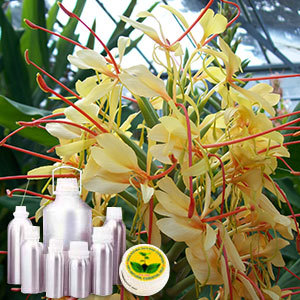Botonical Name | : | Hedychium spicatum | |
CAS # | : | 93455-95-9 | |
Country of Origin | : | India | |
Color & Odor | : | Pale yellow to brownish liquid with green, woodsy scent spicy overtones odor | |
Solubility | : | Insoluble in water, soluble in alcohol and oils | |
Specific Gravity | : | 0.9600 - 0.9900 @ 20°C | |
Optical Rotation | : | N/A | |
Refractive Index | : | 1.4850 - 1.5100 @ 20°C | |
Flash Point | : | >100°C | |
Major Constituents | : | 1,8-cineole , sabinene , terpin-4-ol | |
Plant Part Used | : | Rhizomes | |
Extraction Method | : | Steam Distillation |
DESCRIPTION:
Hydacheim Oil is derived from approximately three feet long Hydacheium tree. Also known as Kapur Kuchari oil, this aromatic fluid is extracted from the inflorescence of the red stamen part of the yellow flowers of this tree. The procured oil has wide applications in medicinal field for its unique antibiotic attributes. CONSTITUENTS:
1,8-cineole , sabinene , terpin-4-ol , γ-terpinene (5.3%) and β-caryophylleneAROMATIC SUMMARY / NOTE / STRENGTH OF AROMA:
The middle note aroma of this fragrant of this fragrant oil has woody smell which is slightly similar to the scent of flower as well as spice extracted essential oils. BLENDS WITH:
This oil easily mixes with Cajeput, Clary Sage, Cassia, Cedar wood, Geranium and Lavender. COMMON NAMES:
Hydacheium Essential Oil is commonly referred as Kapur Kuchari oil and Ulatkambal oil. USES:
Hydacheim oil is acknowledged for its inflammation reducing, asthma treating, aphrodisiac and flatulence relieving attributes. It is also required to formulate tonic and perfumes. 


































